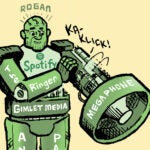 There was a time about five or 10 years ago when “media buyers couldn’t get arrested,” quipped Omnicom Digital CEO Jonathan Nelson at the Mobile Media Summit on Monday, part of Mobile World Congress in Barcelona.
There was a time about five or 10 years ago when “media buyers couldn’t get arrested,” quipped Omnicom Digital CEO Jonathan Nelson at the Mobile Media Summit on Monday, part of Mobile World Congress in Barcelona.
Now the media-buying function sits at the heart of the programmatic revolution happening inside the holding companies.
“It’s the center of the universe,” Nelson said.
But that doesn’t mean creative and messaging should get short shrift – far from it. Programmatic buying is a “huge part of what the media landscape actually is,” he said. “But what seems to have gotten lost is the human factor – the creative side of it.”
“You can have the best targeting suite on the planet, you could find the exact right person, but if you don’t have the right message, what’s the point?” Nelson said. “You shouldn’t even spend the money on the media in the first place.”
Nelson shared his thoughts on mobile video, the future of open exchanges and what’s in store for mobile budgets.
On fragmentation in the programmatic ecosystem:
“As an ecosystem develops, what you see, as in Darwinism, is that the weakest don’t survive, and some of the bigger players like ourselves figure out who’s really adding value to the equation for our clients.
Over time, you’ll see SSPs, DSPs – all that – consolidate down to a number of very significant players. But the good news here is I believe there will be a lot of companies that survive, and we’ll spend money with all different types of partners.”
On the trend away from open marketplaces to programmatic direct:
“As far as I’m concerned, programmatic is really just about the automation of the transaction around media, whether that is an auction … or programmatic direct or programmatic reserved, which is really using programmatic to just do the actual transaction.
The challenge for us is how to guarantee the best of programmatic – the right audience, the right inventory – on an upfront basis, but to take that inventory on a programmatic basis. [From an Omnicom perspective,] you’ll see us move from an open architecture, an open bidding scenario, to a bit more of a closed upfront marketplace.”
On private marketplaces:
“These systems are generally going to be good for publishers. If you’ve got good inventory and if you’ve got premium inventory, we will pay more for it whether it’s upfront or in an open marketplace. You’re starting to see the CPMs for premium inventory rising as we would expect in a premium marketplace.”
On the gap between mobile time spent and the size of mobile ad budgets:
“Anything that’s new takes a while to take root. We’re talking about investment here and people take money quite seriously. We buyers, as agents of our clients, we take that very seriously.
The consumers lead first [and] over time you will watch the dollars flow. The same was true of desktop back in the ’90s. It’s just inevitable mobile and mobile programmatic will catch up to where the marketplace is. But, in the meantime, the market will probably move to something new and we’ll be sitting on this stage five years from now talking about why the Internet of Things marketplace is not evolving the way it should be.”
On mobile programmatic and video:
“Video is by far the most engaging medium. Sight, sound and motion is really where people tend to spend a lot of their leisure time. It’s also where a huge portion of the traditional advertising dollars sit in television. The TV on your wall is being replaced by the TV in your pocket. It’s only a matter of time before that inventory goes to a mobile device. This is how we’ll be doing everything in 10 years.”
On the user experience of television vs. mobile video:
“That’s a real creative challenge. Of course we’re aware that five seconds of pre-roll or post-roll or end-roll is different than 30 seconds on traditional television. The challenge creatively is to get a brand message across with all the action, whatever the deliverable is [and] the KPIs … in a very compressed time format. That’s a challenge which I see as a really great opportunity.”













